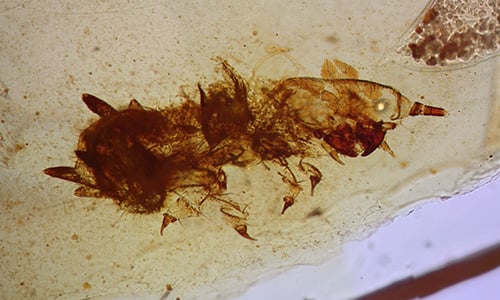27-02-2024
The top 10 articles of PNAS magazine highlights a work with the participation of experts from the Faculty of Earth Sciences and IRBio
The ranking of the 10 articles with the most scientific and media impact published in the journal Proceedings of the National Academy of Sciences (PNAS) in 2023 has highlighted a work involving experts from the Faculty of Earth Sciences and the Research Institute of Biodiversity (IRBio) of the University of Barcelona. The article, entitled "Symbiosis between Cretaceous dinosaurs and feather-feeding beetles", was published in April 2023 and has as co-authors the experts Xavier Delclòs and Sergio Álvarez-Parra, from the Department of Earth Dynamics and the Ocean and the Biodiversity Research Institute (IRBio) of the UB.
A symbiotic relationship between beetles and dinosaurs dates back about 150 million years
The findings of the work indicated that beetles were feeding on dinosaur feathers about 105 million years ago. The study, based on the analysis of new amber fragments from the localities of Sant Just (Terol) and El Soplao (Cantabria), reveals for the first time the symbiotic relationship between dinosaurs and dermestid beetles. These beetles are usually found in bird and mammal nests - where feathers, hair or skin scraps accumulate - and play a key role in the recycling of organic matter in the natural environment.
The amber fragments analyzed contained larval molts of the ancestors of dermestid beetles between the filamentous structures of Cretaceous dinosaur feathers. Thanks to the exceptional preservation that amber allows, the study has revealed this symbiotic relationship that already existed between beetles and dinosaurs some 105 million years ago.
Feathers preserved with the remains of beetle larvae belonged to an unknown avian or non-avian theropod dinosaur, as both types of theropods lived during the Lower Cretaceous and shared often indistinguishable feather types. The feathers studied did not belong to modern birds, as this group appeared about 30 million years later in the fossil record, during the Upper Cretaceous.
The first authors of the work are Enrique Peñalver (Geological and Mining Institute of Spain, IGME) and Ricardo Pérez-de la Fuente (former member of the UB and now Museum of Natural History of the University of Oxford, United Kingdom). Also participating are teams from the American Museum of Natural History and the Natural History Museum of Los Angeles County (United States), the Senckenberg Research Institute (Germany), the Barcelona Botanical Institute CSIC-Barcelona City Council , and other institutions in the country such as the Royal Spanish Academy of Exact, Physical and Natural Sciences, the Autonomous University of Madrid and the Granada Science Park.
Image: CN-IGME/CSIC
